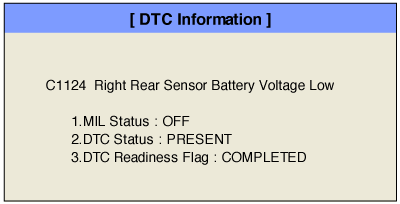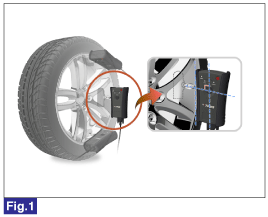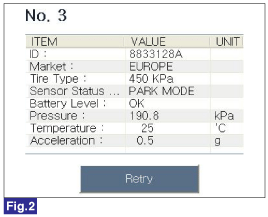Read "DTC Status" parameter.

- History (Not Present) fault : DTC occurred but has been cleared.
- Present fault : DTC is occurring at present time.
Vehicle Parked & Ignition ON.
Connect GDS and select "DTC Analysis" mode.
Click "DTC Status" on the "Diagnostic Trouble Codes(DTC)" menu bar to see DTC's information.
Confirm that "DTC Readiness Flag" indicates "COMPLETED". If not, drive the vehicle within conditions noted in the freeze frame data or enable conditions.
Read "DTC Status" parameter.

- History (Not Present) fault : DTC occurred but has been cleared.
- Present fault : DTC is occurring at present time.
Is parameter displayed "Present fault"?
 | ▶ Go to Next procedure. |
 | ▶ This fault was repaired and TPMS ECU memory was not cleared. Go to "Verification of Vehicle Repair" procedure. |
Set up 'GDS' with 'GDS TPMS'.
Select "Vehicle S/W Management" function.
Select the "Sensor Status" mode of "Data Treatment" item.
Postion the GDS TPMS as near as possible to the tire.(Fig.1)
(Reading may take 30~60 seconds depending on the sensor's characteristics.)
Monitor the parameter of "Battery Level" on the screen.(Fig.2)
Specification : 'Battery Level' is 'OK'.


Fig.1) A method of checking a sensor ID with TPMS Exciter
Fig.2) Data displayed by GDS TPMS(Exciter)
Is parameter within specifications?
 | ▶ Fault is intermittent. It has been repaired and TPMS receiver module memory is not cleared yet. ▶ Go to "Verification of vehicle Repair" procedure. |
 | ▶ After replacing Sensor, you must do the 'Register Sensor' at the "Vehicle S/W Management" mode by using GDS and GDS TPMS. ▶ Go to "Verification of Vehicle Repair" procedure. |